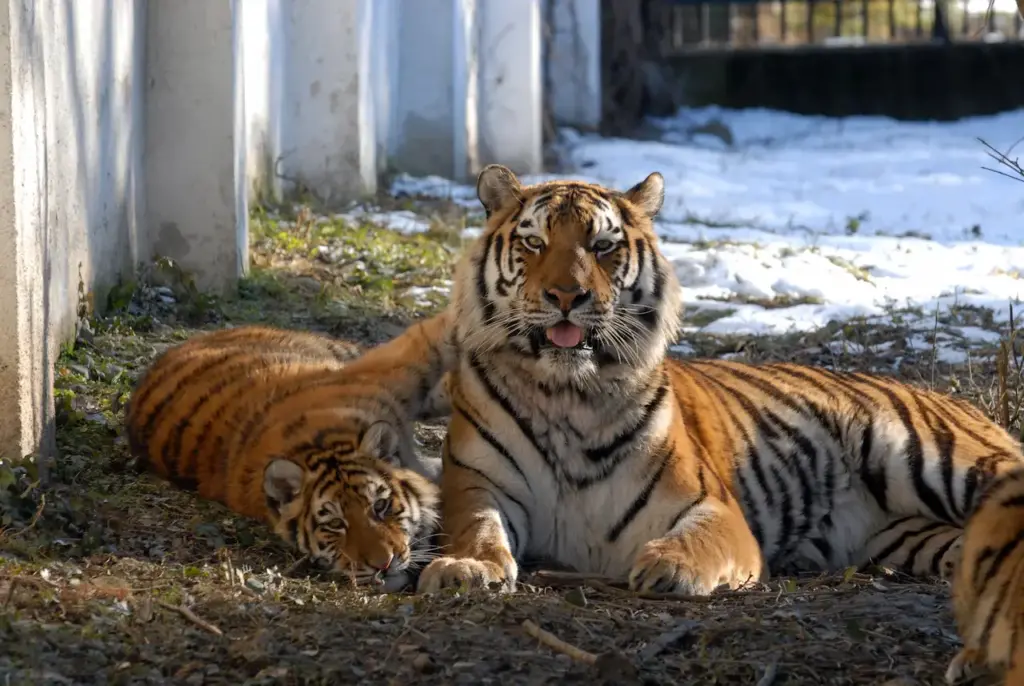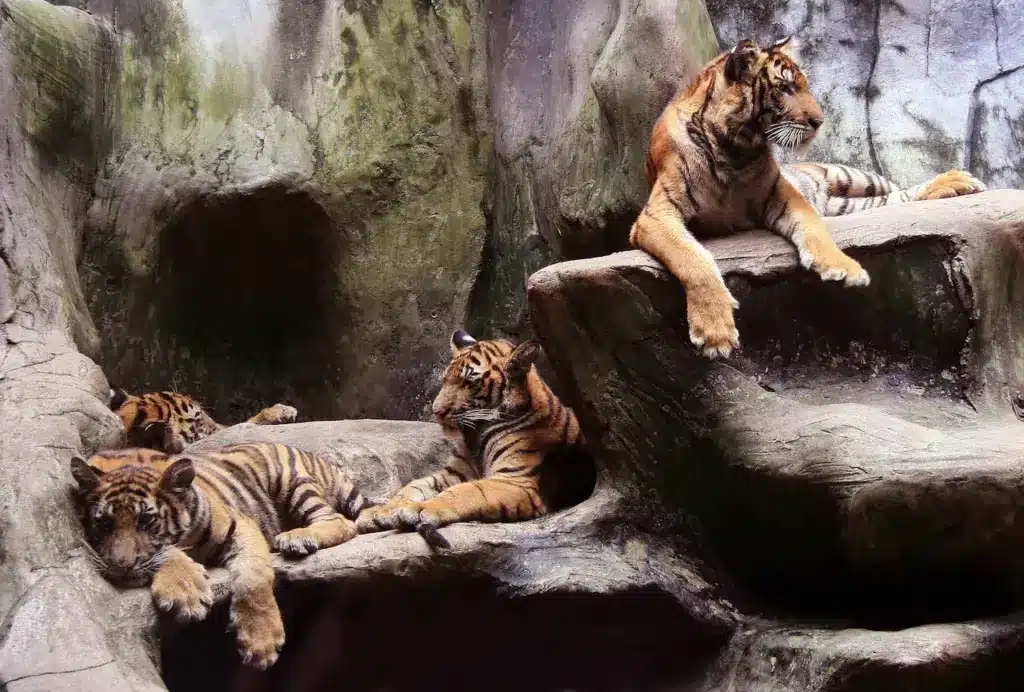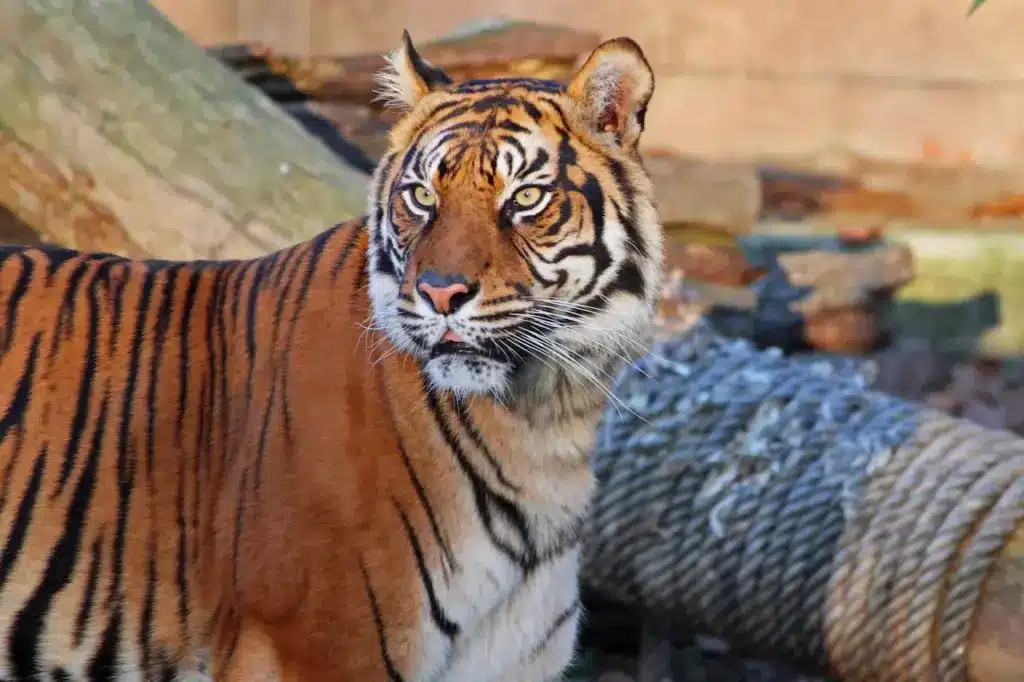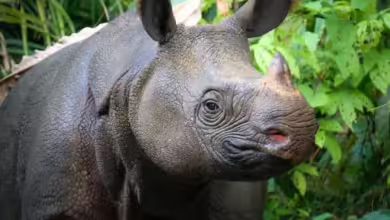Tiger Extinction Would Be China’s Fault
It has been politically correct to say that the world’s remaining tigers are being illegally slaughtered so their body parts can be used to make “Asian folk medicines.” But the truth is that China comprises almost the entire market for tiger parts, and the decision concerning whether the tiger goes extinct in the wild rests solely on the Chinese government.
The Tiger’s Story: China Could Be the Hero—Or The Villain—For All Eternity
BY PAUL GUERNSEY

Tigers in the wild are sliding toward becoming extinct within as few as 10 years. But the Chinese government could prevent their extinction almost single-handedly.
As evidence, international tiger conservationist Judy Mills points to the effectiveness—ruthlessness might be a better term—with which the Chinese rescued the giant panda from the brink of extinction. During the 1980’s and early 1990’s, when it became clear that the illegal hunting of pandas and the trafficking of their parts was about to push China’s most emblematic animal off the face of the earth, the country’s government did two things. First, it launched a massive public-education campaign to teach the Chinese people about the importance of the panda, and to make it socially unacceptable to purchase panda products. Secondly, the government cracked down on panda poachers and traffickers—and it cracked down hard. A few people were even executed for panda-connected offenses.
The result was that the illegal killing of pandas was effectively eliminated, leaving critical habitat loss as the panda’s main roadblock to recovery as a species.
“They practice speed-breeding,” Mills said. “The baby tigers are suckled on pigs and dogs so that the mother can be bred again more quickly.”
Mills, who coordinates the International Tiger Coalition, said in an interview with All About Wildlife.com that tigers don’t have the same habitat problems as pandas; in fact, she said, while there are just above 3,000 tigers remaining in the wild throughout all of Asia, there probably exists sufficient, suitable habitat for 20,000 of the animals in India alone.
“There’s plenty of habitat, and they breed like cats,” said Mills, whose group comprises an alliance of 40 organizations dedicated to halting the trafficking of tigers and their parts. “What we need to do is to stop poaching tigers and their prey.”
That means that, if poachers would only stop killing wild tigers to supply a demand, mostly from within China, for their organs, meat, bones and skins, the species would doubtlessly be able to bounce back, Mills told All About Wildlife.com.
“China can stop this thing on a dime,” said Mills, who told us that she has lived in that country. “When the Chinese government wants to change the hearts and minds of the Chinese people, they can do this more quickly than any other nation in the world.”

Unfortunately, it is not apparent that China has the political will to change hearts and minds on the topic of tiger consumption. Mills said that while she hopes there are no executions this time around, in addition to educating the public and strictly enforcing existing anti-trafficking laws, the Chinese government would also need to take one very difficult step: Shutting down the country’s nascent tiger-farming industry.
Chinese entrepreneurs are poised to turn commercial tiger-farming into a multi-billion-dollar business that would create a “legitimate” public market inside China for a host of tiger products, and conservationists strongly fear that such a market would provide legal cover for illegal trafficking in the pelts and body parts of wild tigers. Once a slaughtered tiger was smuggled across the Chinese border, the traffickers would practically be home free, since without sophisticated genetic analysis, parts from a wild-killed animal would be impossible to distinguish from those of farm-raised one. In effect, conservationists say, the establishment of a “legitimate” Chinese tiger market would encourage the slaughter of wild tigers by making it much easier for wild-tiger traffickers to transport and sell their products.
As a current example of how this dangerous market dynamic works, conservationists point to the legal sales of elephant ivory that international authorities occasionally allow to occur. Many conservation groups assert that, not only do the sales inspire the killing of more elephants by making it easier to sell ivory, but the confusing mix of legal ivory and illegal ivory that has been bureaucratically laundered to appear legal also greatly complicates the enforcement of anti-trafficking laws.
“Extinction is irreversible, so prudence and precaution suggest that the risks of legalized (tiger) farming are too great a gamble for the world to take,” Keshav Varma, director of the World Bank, recently said during a meeting of the international Convention on Trade in Endangered Species (CITES).
Varma also said, “Commercial trading in tiger parts or its derivatives is not in the interest of tiger conservation.”
Whether the Chinese will take that message to heart—or even adhere to international laws that ban trade in tigers or their parts, remains an open question.
According to Mills, who has been deeply involved in tiger conservation for the past 20 years, the Chinese government admits to a captive tiger population of around 6,000—almost double the rapidly declining number of the animals that remain in the wild. She says many of those tigers are kept at large tiger farms—there are at least three major facilities in the country—where litters of tiger cubs are cranked out as fast as possible, puppy-mill style.
“They practice speed-breeding,” Mills said. “The baby tigers are suckled on pigs and dogs so that the mother can be bred again more quickly.”
The businessmen who own those farms have been pressuring the Chinese government to roll back its own 1993 ban on tiger trafficking in order to allow them to start legally moving some of their fast-growing inventory. Mills told us that already, and in spite of the ban, the farms are producing and selling wine in which the bones of tigers have been steeped.
“The wine sells for $100 a bottle,” she said. “We’ve gotten some if it.”
Mills added, “There are some very powerful people in China who are running these places. They stand to make billions of dollars.”
With those billions at stake, and given China’s extreme pro-business focus, the tiger’s fate would seem to be sealed. But Mills said the one, slender thread of hope for tigers in the wild consists of the Chinese people themselves.
“For the pride of their nation, the Chinese do not want to be blamed for the extinction of the world’s favorite animal,” she said. Mills said she was encouraged that Chinese representatives at last month’s Global Tiger Workshop in Katmandu, Nepal, seemed genuinely interested in saving tigers.
“The Chinese, on their own, came up with the idea of doing an awareness campaign in China and in the tiger-range countries,” said Mills, who attended the several-days-long meeting of international conservation organizations, scientists, government representatives from countries where tigers are native, and conservation groups from those same countries. The tiger-range countries include Bangladesh, Bhutan, Cambodia, India, Indonesia, Laos, Malaysia, Myanmar (Burma), Nepal, Russia, Thailand, Vietnam and China itself—although no wild specimens of two of China’s native tiger subspecies, the South China tiger and the Siberian (Amur) tiger, have been observed in the wild in years. The South China tiger is very probably already extinct, while the Amur tiger clings to existence in Russia’s Far East. Meanwhile, a handful of animals belonging to the Indo-Chinese tiger subspecies apparently survives in in southeastern China.
Mills said she received further encouragement from the fact that, with the Chinese Year of the Tiger (2010) fast approaching, and tigers clearly teetering on the brink of extinction, high government officials in some of the tiger-range countries have finally begun to take a serious interest. She said that not only did the prime ministers of India and Nepal both pledge their support for tiger conservation, but Vladimir Putin, Russia’s Prime Minister and former president, will be hosting next year’s 2010 Year of the Tiger Summit in Vladivostok.
“In all the years I’ve worked with tigers, I’ve never seen that level of interest,” Mills said. She added, “At that level of diplomacy there could be the proper political will and the amount of resources” to save tigers.

She cautioned, however, that it still remains to be seen whether the well-intentioned national leaders, who are all pressed by a myriad other problems, will follow through on their Katmandu promises.
As for Putin, he became involved close to the same time that scientists working in Far Eastern Russia announced that, after remaining stable, and even increasing slightly for the last several decades, Russia’s population of Siberian tigers had once again begun to drop. The cause: Poaching.
Mills told us that by the end of March, conservationists will probably have a good idea about China’s real intentions regarding tiger conservation—and at the same time, perhaps, a definitive answer to the question of whether wild tigers will be on the earth for very much longer.
She said that during the upcoming March meeting of CITES, in Doha, Qatar, the European Union plans to propose strengthening regulations against the commercial exploitation of tigers.
“If we see China fighting that in Doha, then hopes are slim,” Mills said.
She concluded, “It comes down to China. If the tiger goes extinct, China will be blamed for all eternity.
“China can either be the cause of the tiger’s extinction in the near term, or it can be the hero that buys the wild tiger the time it needs to make a comeback.”
Read more about tigers and the endangered tiger subspecies.



